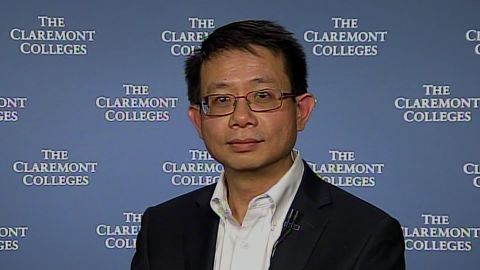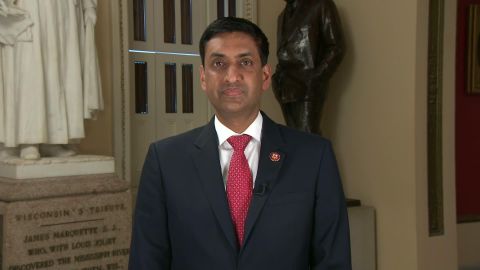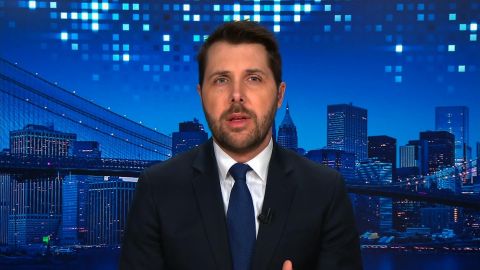Read Transcript EXPAND
CHRISTIANE AMANPOUR: Gilbert Gee is a professor at UCLA’s Fielding School of Public Health. And he says it reminds him of what happened during the SARS crisis and also in the United States during the AIDS crisis. And as the battle against the coronavirus continues, Gee tells our Hari Sreenivasan about the hidden cost of epidemics.
(BEGIN VIDEOTAPE)
HARI SREENIVASAN: So, Professor Gee, we have reports now of hate crimes in the New York City subway system, for example, where an Asian woman wearing a mask was attacked and called diseased. How far back does this history go of using health to discriminate against people?
GILBERT GEE, UCLA FIELDING SCHOOL OF PUBLIC HEALTH: Yes, it goes back a couple hundred years. And part of it really has to do with, I think, justifying slavery. You know, it’s kind of a difficult proposition to say that we are in a democracy, and at the same time have multiple classes of people that are stratified purely based on their race. And so one way to get out of that intellectual moral conundrum is to say that other races are not equal to us in terms of being human beings. And so we have a long history of using science as a way to justify race differences. There was a pseudoscience called phrenology where they purported to measure, say, bumps on people’s heads and then, from there, infer things like intelligence. So we have had a long history of actually medicine and public health and scientific research that’s been used to justify that, hey, these racial groups are actually fundamentally different in terms of their physiology. And from that, we have made a lot of mistakes in the research, you know, giving some examples such as the Tuskegee syphilis study, which you may or may not have heard of. But the Tuskegee study was a study of the course — trying to understand the course of syphilis amongst African-Americans in the United States, with the underlying idea that black bodies reacted to syphilis differently than white bodies. But by the time that study was actually initiated, we already knew that syphilis — we already knew the basic biology and mechanisms of syphilis. But there was still this underlying belief that, well, persons of African descent are fundamentally biologically different, so let’s continue with that body of research. So, from that understanding of this basis that — or this belief that racial groups are biologically different, that’s when we start to have these continuing sort of completions of, oh, this disease has broken out, and it’s sort of common amongst this population, and so, therefore, we need to be careful and watch out about that population, maybe what the policy response should be — would be to deport them or to quarantine them or to not let them into our country or to this particular city. So, we definitely have a long history of using science to justify racism. And now we know that most of that science has just been incorrect and totally biased.
SREENIVASAN: The West Coast has a longer history with Asians than the rest of the country does. What were some of the things that happened around the turn of the century, or, I should say, the turn of the previous century, now that we’re in 2020–
GEE: Yes.
SREENIVASAN: — in the late 1800s and the 1900s, where you could see these kind of racially discriminatory policies have a root in public health concerns?
GEE: As you mentioned, like, states like California had a fairly large population of, say, Chinese immigrants, and as well as immigrants from other countries. And, basically, what happened was, a lot of these immigrants were used as strike-breakers. And so then what happened is, the local workers, American workers, were quite unhappy with that, and started to lobby, you know, saying that we should exclude these individuals, and that they started to make connections, not only in terms of economic grounds, but using public health as a justification, the idea that Chinese persons were prone to have leprosy, and that defending against leprosy was actually a good reason to exclude Chinese persons. You know, so using public health, for example, as a rationale to systematically exclude individuals, so that would be, like, another example.
SREENIVASAN: Your research has pointed out, I mean, going back as far as the Chinese Exclusion Act or the Chinese–
GEE: Yes.
SREENIVASAN: — and how they were kind of quarantined in San Francisco, while their white neighbors weren’t, and we have seen this happen to population of Filipinos and Hawaiians.
GEE: Yes.
SREENIVASAN: So, why is it that this keeps repeating?
GEE: Right. We have this belief system that racial groups have these innate attributes. And that’s linked to disease. So, there used to be a thought that — for example, that even things like poverty were infectious in some and transmissible in some nature. So if you kind of think that we have this basis of understanding that certain racial groups are certain ways, and that if these groups have a certain predisposition to be sick, and then, suddenly, they are coming in to infect all these other good people that aren’t necessarily sick at this moment in time, then you can start to see how race and racism and disease starts to get conflated all together.
SREENIVASAN: Now, look, this is also happening. And the backdrop is the United States has declared a public health emergency. They’re going to deny entry to foreign nationals who’ve been to mainland China. And you have got private companies like Royal Caribbean cruise ship recently said that they are not going to allow anyone to board if they have passports from mainland China or Macau or Hong Kong.
GEE: Right.
SREENIVASAN: And then we also literally see countries evacuating their citizens out of specific regions of China. So, I mean, shouldn’t people be concerned? I mean, that all creates a climate where we’re watching TV and saying, this must be pretty bad if all of these steps — these countries and these companies are taking these steps.
GEE: Well, with any outbreak, we should be concerned. This is a novel pathogen that we’re encountering. And we are, as human beings, considered what the epidemiologists call a virgin population. It’s a — we don’t have necessarily an immunity in the population that has encountered this specific coronavirus before. So our bodies are encountering it anew. So we don’t necessarily have the defense system within our bodies, both as individual persons, as — and as community members, to kind of protect ourselves, that we might protect ourselves against something like, say, measles and whatnot.
SREENIVASAN: Yes.
GEE: But it’s also important to keep what we’re understanding in perspective. The — right now, we’re still learning about the natural course of this disease and the biology of it. But, currently, we’re — the best estimate I have seen is, right now, the fatality rate is something like 3 percent. And if you put that in perspective of, say, something like SARS, I think the fatality rate for SARS was 10 percent. And I think MERS was something like 30 percent. So, in sort of that big picture, it’s relatively small. I’m not saying people should not be concerned, but if we start to put it in perspective. Another way to think about it is, influenza, the common flu, has, I think, this year affected something like 19 million Americans. But we are not exactly panicking in the same way as we are with the coronavirus. And I think part of the reason is that we’re so used to the flu, and we’re so used to having people be sick to it, that it’s no longer a novel threat. So I think part of this reaction to the coronavirus is really part of the novel — is really the novelty of the disease.
SREENIVASAN: You were just saying SARS. What are the things that we learned from that epidemic?
GEE: I think we learned a little bit more about coronaviruses in general. And, certainly, it’s part of the same family, SARS and the novel one that we’re encountering today. I think we’re also learning a little bit more about being sensitive to communities and really trying not to stigmatize certain communities in relation to that. So, like, I think, currently, the media response has been a lot better with regards to many media outlets saying, hey, let’s not be xenophobic and let’s not — let’s try not to discriminate against certain groups of people. You saw that happen with SARS and a few other outbreaks such as that. I think the general response has been a little better.
SREENIVASAN: I was looking over some of the coverage. We have got papers in Australia who’ve done front-page, above-the-fold headlines such as “China Kids Stay Home.”
GEE: Yes.
SREENIVASAN: There’s a paper in France that had a front page with words “Yellow Alert” or “Yellow Fever.”
GEE: Yes.
SREENIVASAN: I mean, what are the public health consequences when a community is singled out or stigmatized?
GEE: So, I think there’s several layers to that. So, first of all, I think that we understand from a growing body of literature that people who experience discrimination tend to get sicker. And so experiencing discrimination triggers a stress response, and that, in turn, can lead to other kinds of illnesses that are above and beyond what we’re seeing with the coronavirus. It can have sort of long-term effects on things possibly like cellular aging, heart disease and everything. So there are some long-term effects that might be related to sort of the short-term experiences of discrimination and xenophobia in that sense. I think another piece of it is, we run the risk of allowing for the — it OK to be discriminatory in our societies. And I think many societies are really trying to move away from that. But diseases somehow allow people to express their xenophobia.
SREENIVASAN: It seems logistically, also, if you singled out communities, they might be less willing to come forward when they do have symptoms.
GEE: Yes. And we see that in other cases. So, for example, research on HIV and other things like that, where we find that diseases are stigmatized, a lot of times, people become reluctant to seek help because they don’t want to be further stigmatized. And it can certainly be a problem, where people decide, I’m just going to hold myself underground because people are going to discriminate against me. So, that certainly can happen.
SREENIVASAN: What responsibility do you think that the Chinese government plays in how this information has created this environment? Meaning, one of the things that we know in the past is that they have tried to keep a lid on things. And, in this particular case, we recently just had the reports that the doctor who was a whistle-blower, one of the doctors who was a whistle-blower, who tried to get the word out about this in December, the local authorities actually chastised him and penalized him for it. And he’s just recently died of the virus. So, if you’re a government, if you’re trying to both take care of your people and of your image, what’s the best thing that they should have done, could have done?
GEE: I think probably a better thing to do would be to, A, first not chastise and do exactly what they did. I think it’s — especially in this global world that we live in, my opinion is that more transparency, the better, and the more we can communicate with scientists and medical practitioners, so that we can have a better understanding of where the diseases are originating, what exactly is happening, how things are being communicated, because, in the world we live in, where we — we have transportation that takes us literally to all corners of the Earth. We also have all these other kind of businesses that require transnational agreements and movement of goods, and as well as people and livestock and things like that. And, of course, you have animals that don’t care about national boundaries. It’s really important, I think, for scientists and governments to cooperate with each other and be as transparent as possible, so we have information and so that we can move rapidly and use accurate information.
SREENIVASAN: So, what’s a government to do to try to prevent this surface- level discrimination–
GEE: Yes.
SREENIVASAN: — and structural discrimination, if they have a population that is scared?
GEE: Yes. So I think an important thing is to have consistency in the communications. So, in the broader literature on disaster communications, it’s really important to have messages that are coming, say, from the health department and from your physicians and other places, such as school principals, all giving somewhat consistent information, because I think what happens is, when the public is getting information from source A and source B, and they’re conflicting, then people get really confused. And that’s when people start to get much more scared and feel like things are not under control. So, the more consistency we can have with messaging, with the more these different bodies can communicate with one another, and provide accurate information, and in a timely manner as possible, I think that’s one of the better-case scenarios.
SREENIVASAN: If you could just compare the responses — you have been studying things like MERS and SARS and even this coronavirus. Compare that, let’s say, to HIV or to Ebola, things that had kind of the world on edge.
GEE: Well, let’s see. I am not an expert on a lot of those other outbreaks. But I do think that we’re in a different moment in time. I do think that the Internet and the information environment is quite different than what we had before. We have learned some lessons from the past. We’re more careful now to not label diseases and conflate them with people. So, like, using HIV as an example, one of the early names for it was GRID, which was gay-related immune disease, which obviously singled out a specific population. And we know that, even though people can discriminate, diseases don’t. And so it’s something for us to really pay attention to. I think there’s definitely a long way to go in terms of teaching all of us to — and always to remind ourselves that we can’t and shouldn’t stigmatize individuals and discriminate against them simply because a disease originated in a certain place in the world.
SREENIVASAN: Professor Gee, thanks so much for your time, Professor Gilbert Gee from the School of Public Health at UCLA. Thanks for joining us.
GEE: Thank you so much. This was a real pleasure.
About This Episode EXPAND
Brian Deese, global head of sustainable investing at BlackRock, tells Christiane how his company is embracing sustainability. Ro Khanna, co-chair of the Bernie Sanders campaign, discusses what the New Hampshire victory means for the Democratic party’s direction. Professor Gilbert Gee joins Hari Sreenivasan to discuss the hidden cost of global epidemics. Plus, a special report on the Coronavirus.
LEARN MORE


